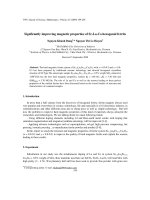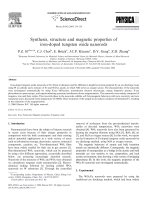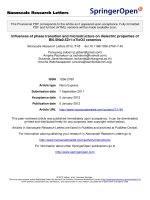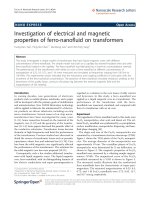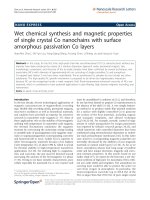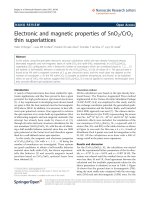Microstructure and magnetic properties of cozr and co doped tio2 thin films
Bạn đang xem bản rút gọn của tài liệu. Xem và tải ngay bản đầy đủ của tài liệu tại đây (2.56 MB, 96 trang )
MICROSTRUCTURE AND MAGNETIC PROPERTIES
OF COZR AND CO-DOPED TIO2 THIN FILMS
YAO XIAOFENG
NATIONAL UNIVERSITY OF SINGAPORE
2003
MICROSTRUCTURE AND MAGNETIC PROPERTIES
OF COZR AND CO-DOPED TIO2 THIN FILMS
YAO XIAOFENG
A THESIS SUBMITTED
FOR THE DEGREE OF MASTER OF ENGINEERING
DEPARTMENT OF ELECTRICAL AND COMPUTER ENGINEERING
NATIONAL UNIVERSITY OF SINGAPORE
2003
Acknowledgement
First, I would like to show my appreciation to National University of Singapore and Data
Storage of Institute for providing me this research opportunity and scholarship.
Also, thanks to my project supervisors who give me great help in this work. Special
thanks go to Professor Wang Jian-Ping and Dr. Zhou Tiejun for their great patience and
enlightening guidance during the course of the entire project. When I meet difficulties,
their encouragements help me get rid of the confusion smoothly. And I would like to
thank Professor Chong Tow Chong for his support throughout this study.
I wish to express my gratitude to the staff and scholars of Media Materials Group of Data
Storage Institute of Singapore. The active discussions throughout the course were
extremely beneficial. Special thanks go to Dr Dai Daoyang for the help of TEM and XRD
experiments. I also thank Lim Boon Chow and Dr. Branko Tomcik for their great help
and support in sputtering system. And thanks to Dr. Sun Chengjun for the fruitful
discussion in the microstructure part.
I would also like to acknowledge my thanks to Gai Yaxian in FAC Group of Data
Storage Institute for the great help of XPS measurement.
Last but not least, I would like to thank my parents and sister for their constant love and
encouragement.
i
Table of Contents
Acknowledgement
i
Summary
vi
Nomenclature
viii
List of Figures
x
List of Tables
xiii
Chapter 1 Introduction
1
1.1
Application on Data Storage
2
1.1.1
History of magnetic recording
2
1.1.2
Principle of magnetic recording
4
1.1.3
Magnetic recording media
6
1.1.4
1.3
1.1.3.1 Thin film media
6
1.1.3.2 Patterned media
8
Basic magnetic phenomena on magnetic recording
9
1.1.4.1 Magnetostatic energy and demagnetization energy
9
1.1.4.2 Magnetic anisotropy
10
1.1.4.3 Magnetization reversal mechanism
10
Application on Spintronics
13
1.3.1
Introduction of spintronics
13
1.3.2
GMR effect
14
1.3.3
Spin valve in magnetic recording
15
ii
1.3.4
Magnetic tunnel junction in nonvolatile memories
15
1.3.5
Quantum computation in the future
16
1.3.6
Materials for spintronics application
17
Reference
18
Chapter 2 Experiment Methods and Characterization Tools
22
2.1
Thin film deposition: magnetron sputtering
22
2.1.1 Principle of sputtering
22
2.1.2 Working pressure
25
2.1.3 Substrate temperature
26
2.1.4 Sputtering power density
27
2.2
Post-annealing process
27
2.3
Vibrating Sample Magnetometer (VSM)
27
2.4
Alternating Gradient Force Magnetometer (AGFM)
29
2.5
X-Ray Diffractometer (XRD)
30
2.6
Transmission Electron Microscope (TEM)
31
2.6.1 Principle of TEM
32
2.6.2 Basic layout of TEM
32
2.6.3 TEM sample preparation
33
2.6.4 TEM images
34
2.7
Energy Dispersive X-Ray Microanalysis (EDX)
35
2.8
Inductively-Coupled-Plasma-Optical Emission Spectrometer
35
2.9
X-ray Photoelectron Spectroscopy (XPS)
36
iii
2.9.1 Principle of XPS
37
2.9.2 Qualitative analysis
37
Reference
38
Chapter 3 CoZr System
40
3.1
Literature review
40
3.2
Experiments
42
3.3
Results and discussion
41
3.3.1 Zr content dependant property
41
3.3.1.1 As-deposited state
41
3.3.1.2 Post-annealed state
42
3.3.2 Detailed studies on Co40Zr60 set samples
3.4
45
3.3.2.1 Phase studies
45
3.3.2.2 Thermomagnetic analysis and calculation
46
3.3.2.3 Microstructure studies
49
3.3.2.4 Annealing time effect studies
51
Summary
52
Reference
54
Chapter 4 Co-doped TiO2 System
57
4.1
Literature Review
57
4.2
Experiments
58
4.2.1 Thin film deposition
58
iv
4.3
4.2.2 Post annealing treatment
61
4.2.3
61
Results and Discussion
62
4.3.1
Co concentration analysis
62
4.3.2
Binding state and neighbor environment analysis
65
4.3.2.1 Post annealing effect
66
4.3.2.2 Layer structure dependent property
68
4.3.2.3 Sampling depth dependent property
69
4.3.2.4 Co concentration effect
73
Microstructure analysis
73
4.3.3
4.4
Characterization
4.3.4 Magnetic property analysis
74
Summary
76
Reference
77
Chapter 5 Conclusion
79
5.1
CoZr system
79
5.2
Co-doped TiO2 system
80
Publications and Presentation
81
v
Summary
With the fast development of computer technology, magnetic materials play an
increasingly important role in the modern society. As the dominant stem of present data
storage media, magnetic recording media enter a high developing era with more than
100% growth rate of areal storage density per year. At the same time, the rapid progress
of nanotechnology and the raising requirements of electronic devices lead to the novel
application of magnetic materials, especially in spintronics.
In this work, two kinds of new magnetic materials were investigated systematically,
focusing on the application on data storage and spintronics, respectively. One was CoZr
thin film for patterned recording application and the other is Co-doped TiO2 thin film as a
promising candidate for spin injector.
In the first part, microstructure and magnetic properties of CoZr films were investigated
in detail, which is for the application of phase transition method to fabricate patterned
nanostructures. It is proved that post annealing is effective to induce the phase transition
of CoZr thin films from as-deposited non-magnetic state to annealed ferromagnetic state.
For Co40Zr60 thin films, phase change occurs after annealing at 550°C for 2 hours. The
annealing temperature needed for phase change is much lower than that of rapidly
quenched bulk samples. Co11Zr2 and Co23Zr6 magnetic phases are formed after annealing,
which lead to the enhancement of the magnetism of annealed samples. And, the
calculations on Transmission Electron Microscopy-Selected Area Diffraction (TEMSAD) patterns show that the enlarged grain size may be another source. Moreover, Ms of
vi
these two phases were calculated based on Thermomagnetic Analysis (TMA) data.
Perpendicular magnetic anisotropy is revealed in annealed samples.
In the second part, Co-doped TiO2 thin films are studied, which have different layer
structures, different Co concentration, and different post-annealing conditions. XPS
analysis on the binding state of Co and Ti atoms in the thin films were reported for the
first time for this system. Microstructure and magnetic behavior were studied as well.
Based on XPS Co2p narrow scan patterns, Co(Ⅱ) binding state is found in most annealed
samples, and its intensity increases with the annealing temperature. It is proved that postannealing is an efficient way to drive Co atoms to diffuse into TiO2 layers and substitute
for Ti in the lattice. It is very interesting to find that samples with partial co-sputtering
structure have much stronger Co(Ⅱ) peak in XPS patterns than those of multilayer
structure. TEM-SAD patterns show that the annealed films have poly-crystal rutile-TiO2
phase. Co-fcc phase is not found in annealed films. The low-temperature VSM
measurement shows the saturation magnetization at 150 K is 1.325 uB per Co atom,
which is close to the value expected for low-spin Co(Ⅱ).
vii
Nomenclature
AFM
Atomic Force Microscope
AGFM
Alternating Gradient Field Magnetometer
Co
Cobalt
Cr
Chromium
d
lattice plane distance
fcc
face centered cubic
Fe
Iron
FWHM
full width half maximum
Gbit/in2
gigabit per square inch
GMR
giant-magneto resistance
H
magnetic field
Hc
coercivity
hcp
hexagonal close-packed
Hd
demagnetising field
Hex
exchange field
ICP-OES
inductively-coupled-plasma optical-emission-spectroscopy
J
antiferromagnetical coupling constant
Ku
magneto-crystalline anisotropy constant
KB
Bolzman constant
LAC
Laminated Antiferromagneticallay Coupled
M
magnetization
Mr
remanent magnetization
Mrt
remanence thickness product
viii
Ms
saturation magnetization
MFM
magnetic force microscope
PAr
Argon gas pressure
S
remanent squareness
S*
coercive squareness
SNR
signal-to-noise ratio
Tbit/in2
terabit per square inch
Tsub
substrate temperature
TEM
transmission electron microscope
TMA
thermo-magnetic analysis
Ti
Titanium
VSM
vibrating sample magnetometer
XRD
x-ray diffraction
Zr
Zirconium
α
loop slope parameter
δ
film thickness
λ
wavelength of X-ray or electron beam
µ0
magnetic permeability of vacuum
ix
List of Figures
Fig.1.1
Hard Disk Areal Density Trend
2
Fig.1.2
Random Access Method of Accounting and Control
3
Fig.1.3
Principle of longitudinal magnetic recording
4
Fig.1.4
Schematic of patterned media and the patterned structure
5
obtained by ion beam bombardment self-assembly
Fig.1.5
Schematic of (a) perpendicular media and (b) longitudinal media
6
Fig.1.6
Schematic of (a) in-plane and (b) vertical patterned media
8
Fig.1.7
Hysteresis curves for a single-domain particle for four angles
12
θ0 between the easy axis and the applied field.
(θ0=0°, 30°, 80°, 90°)
Fig.1.7
Schematic diagram of the Stoner-Wohlfarth model
7
Fig.1.9
Spin-dependent transport structures:
15
(A) spin valve and (B) Magnetic RAM (MRAM)
Fig.2.1
Schematic depiction of a typical sputtering system
23
Fig.2.2
Schematic diagram of the principle of Magnetron Sputtering Method
24
Fig.2.3
Thornton zone diagram showing thin film microstructure as
26
a function of Ar pressure and substrate temperature
Fig.2.4
Photograph of Vibrating Sample Magnetometer
28
Fig.2.5
Photograph of Alternating Gradient Force Magnetometer
30
Fig.2.6
General configuration of Philip’s X’pert XRD system
31
Fig.2.7
Inductively Coupled Plasma- Optical Emission Spectrometer
36
Fig.2.8
XPS spectrum of Iron
38
x
Fig.3.1
Saturation magnetization of Co1-xZrx thin films in as-deposited state
42
Fig.3.2
The development of in-plane and out-of-plane hysteresis loops of
44
annealed CoZr films following the change of Co concentration
Fig.3.3
Saturation magnetiztion (Ms) as a function of the Zr content
44
at different annealing temperatures.
Fig.3.4
XRD patterns of Co40Zr60 as-deposited sample and annealed samples
46
Fig.3.5
TMA curve of annealed Co40Zr60 sample (550 °C, 2 hours).
49
Fig.3.6
SAD pattern of annealed Co40Zr60 sample (550 °C, 13 hours)
53
Co11Zr2 and Co23Zr6 phases were formed
Fig.3.7
Saturation Magnetization (Ms) dependent on annealing time of
54
Co40Zr60 samples (fixed annealing temperature at 500 °C)
Fig.3.8
Out-of-plane coercivity dependent on annealing time of Co40Zr60
54
annealed samples (fixed annealing temperature at 500 °C)
Fig.4.1
Schematic pictures of sample layer structures. (a) partial
58
co-sputtering structure, (b) pure multilayer structure
Fig.4.2
Annealing temperature effect of CoxTi1-xO2 films with partial co-
64
sputtering structure. Co concentration is fixed at 5.62 at%
Fig.4.3
Layer structure dependant property of annealed Co-doped TiO2 films.
65
Fig.4.4
XPS patterns with different sampling depth of the same
67
annealed sample
Fig.4.5
XPS patterns of pure multilayer sample with different
69
sampling depth
xi
Fig.4.6
XPS narrow scan patterns of Ti2p peak with different
69
sampling depth
Fig.4.7
XPS patterns of samples with different Co concentration
69
Fig.4.8
TEM Selected-Area Diffraction pattern of annealed Co-doped
70
samples. Rutile-TiO2 phase is dominant in the film.
Fig.4.9
Saturation magnetization dependant on annealing temperature
71
Fig.4.10
Low temperature (150 K) hysteresis loop of annealed samples
72
with partial co-sputtering structure. Ms is 1.325 uB per Co atom,
which is close to the value of low-spin Co(II) state
xii
List of Table
Table 3.1
Co1-xZrx thin films deposition parameters
42
Table 3.2
Standard diffraction data of two magnetic phases
47
Table 3.3
Calculation of grain sizes of annealed samples with different
52
annealing temperature
Table 3.4
Comparison between TEM-SAD results and XRD results
52
Table 4.1
The list of as-deposited samples with different layer structure
58
Table 4.2
ICP-OES results of CoxTi1-xO2 thin films
60
Table 4.3
Calculation results on each layer thickness in as-deposited
62
samples based on ICP results
xiii
Chapter 1 – Introduction
Chapter 1 Introduction
The goal of this introduction chapter is to give a short overview on the applications of
magnetic materials on data storage and spintronics. Some basic and important
background knowledge will be highlighted.
The story of magnetism begins with a mineral called magnetite (Fe3O4), the first
magnetic material known to man. In the ancient world the most plentiful deposits of
magnetite occurred in the district of Magnesia, in what is now modern Turkey, and
our word magnet is derived from a similar Greek word, said to come from the name
of this district.
Ferromagnetic material is one of the most important types of magnetic materials. In
this material, there are domains in which the magnetic fields of the individual atoms
align, but the orientation of the magnetic fields of the domains is random, giving rise
to no net magnetic field. When an external magnetic field is applied to them, the
magnetic fields of the individual domains tend to line up in the direction of this
external field, which causes the external magnetic field to be enhanced.
Magnetic materials have already been widely used in many fields, such as data
storage, mechanical and electrical energy conversion, electron control and force
application. In recent years, the rapid progress of nanotechnology leads to novel
application of magnetic materials in spin electronic devices, magnetic sensors, and
functional materials. New magnetic materials are needed, which can meet the high
performance requirements of future application. In my work, new magnetic materials
on data storage and spintronics have been investigated systematically. The following
introduction will focus on these two application fields.
-1-
Chapter 1 – Introduction
1.1
Application on Data Storage
1.1.1
History of magnetic recording
Magnetic hard disk drives have undergone vast technological improvements since
their introduction as storage devices over 45 years ago, and these improvements have
had a marked influence on how disk drives are applied and what they can do. Areal
density increases have exceeded the traditional semiconductor development trajectory
and have yielded higher-capacity, higher-performance, and smaller-form-factor disk
drives, enabling desktop and
mobile computers to store
multi-gigabytes of data easily
[1]. Today, when we are
familiar with the 1.6 Kg IBM
laptop and 40 Gigabits hard
disk, it is hard to imagine
what the first computer in the
world looks like. Within only
half of a century, magnetic
recording
technique
grows
sharply from zero point to
doubling each year of today.
Fig.1.1 Hard Disk Areal Density Trend [1]
(Fig.1.1) As early as 1928,
Australia inventor created first magnetic tape, which indicates the beginning of
magnetic recording. In 1948, University of California-Berkeley computer project
created first magnetic drum to store binary data (800 bits/in2). 1956 is the most
important milestone for magnetic recording, IBM unveiled the RAMAC (Random
-2-
Chapter 1 – Introduction
Access Method of Accounting and Control), the world’s first system for storing
computer data on magnetic disks (Fig.1.2). In 1973, the Winchester drives were first
introduced. They contained two spindles, each holding 30Mb of data. The Winchester
was the first multi-platter drive available and spawned many new technologies. Five
years after the Winchester drive was introduced, RAID (Redundant Arrays of
Independent Disks) hit the market. This not only sped up data access and allowed
more storage, but also introduced the concept
of redundancy in computer systems for
reliability. By 1987 the University of California
at Berkeley had defined the RAID levels still in
use today. In the following a few years, the
developing step of hard disk was limited by the
performance of magnetic head, which was not
strong or sensitive enough to detect higher
density media. This barrier was broken in 1991.
IBM pioneered the use of magnetoresistive
(MR) heads for disk drives, which bring an
Fig.1.2 RAMAC [1.2]
extraordinary increase of areal density (60%
per year). Another revolution on hard disk was induced by the use of giant
magnetoresistive (GMR), which leaded to Compound Growth Rate (CGR) reach to
100% per year. Hard-disk drive data densities have doubled annually for the past five
years, but disk drive designers worried that future progress would be prevented by the
impending inability of ever-smaller magnetic-alloy grains to retain their magnetic
orientations [5,6]. In 2001, antiferromagnetically coupled (AFC) media was
introduced. AFC media makes clever use of three layers to stabilize the magnetic
-3-
Chapter 1 – Introduction
orientations. With this new design, Fujitsu smashed hard disk recording density
record of 106Gb per square inch. Al Hoagland, one of the pioneers on magnetic
recording, once said that: “ In my personal time frame, I have witnessed improvement
in areal density by a factor of ten million. I can think of no other technology where
such dramatic progress could occur over the span of your career.”
1.1.2
Principle of magnetic recording
For magnetic recording, a recording medium and a recording head are needed. Fig.1.3
illustrates the recording process using a single-track ring head. The recording medium
consists of a substrate coated with a material that can be permanently magnetized,
thus permitting information to be stored magnetically. The recording head is an
electromagnet with a gap that has to be located near the medium. The head coil is fed
with a current containing the information to be recorded. Upon moving the head at
constant speed relative to the medium, the fringing fields from the head gap
permanently magnetize the medium and the information is stored. At replay, the
medium is again moved
past the head and the flux
emanating
from
the
medium and entering the
head gives rise to a readback signal. For magnetoresistive read head, the
read-back signal comes
from the change of the
head resistively, which is
Fig.1.3 Principle of longitudinal magnetic recording[3]
brought about by the magnetization of the media.
-4-
Chapter 1 – Introduction
Different modes of magnetic recording exist and can be defined based on the direction
of the magnetization or magnetic anisotropy, namely longitudinal magnetic recording
(LMR) and perpendicular magnetic recording (PMR). In perpendicular recording, the
bits are stored by arranging magnets vertically, with opposite poles facing each other
and is therefore more stable at high-storage densities. It is believed that perpendicular
recording technology will take over the existing longitudinal technology in the near
future. The most popular perpendicular recording media which are widely
investigated are Co/Pd multilayers and FePt films. These materials have potential to
support densities up to 1 trillion bits per square inch.
In both the longitudinal and perpendicular recording, one bit is stored in a group of
many small grains and is therefore thermally unstable. However, in patterned media
recording, one bit is stored by one grain and therefore, the grain can be larger
(Fig.1.4). Therefore, the integrity of the data can be maintained even at densities
higher than 1 trillion bits per square inch.
Fig.1.4 Schematic of patterned media and the patterned structure
obtained by ion beam bombardment self-assembly. [58]
-5-
Chapter 1 – Introduction
1.1.3
Magnetic recording media
1.1.3.1 Thin film media
Modern hard disk media incorporate a glass or a NiP-coated aluminum alloy substrate
on which a thin film stack is sputtered. The stack consists of one or more underlayers
or seed films, a magnetic film, and an overcoat. The magnetic film is a polycrystalline
alloy of Co, Cr, and Pt, with additional elements such as B or Ta, and is sputtered at
elevated temperatures to promote segregation of non-magnetic elements to the grain
boundaries, leading to partial exchange-decoupling of the magnetic grains. Each ~10nm-diameter grain therefore behaves as a single-domain particle with easy axis
parallel to the film plane in longitudinal media (Fig.1.7 b). During the recoding
process, small areas of the film (bit cell) are magnetized parallel or antiparallel to the
track direction; it is the fringing fields from the magnetization transitions between
these areas that are detected by the head during readback [12].
In high-density media, each bit cell contains of order 100 grains. Transition noise,
Fig.1.5 Schematic of (a) perpendicular media and (b) longitudinal media
originating from irregularities or jaggedness in the magnetization transitions, and
increased by collective reversal of groups of grains, dominates the overall signal-tonoise ratio (SNR) of the system. Both the SNR and the minimum width of the
transition depend on the grain size of the medium. As the down-track linear bit
density increases, the grain size must decrease to maintain an acceptable SNR.
However, the grains begin to exhibit thermal instability when the ratio of thermal
-6-
Chapter 1 – Introduction
energy kT (k is Boltzmann’s constant and T the temperature) to magnetic energy KV
(K is the magnetic anisotropy and V the grain volume) exceeds a certain ratio. For
isolated grains, stability over a time scale of, for example, 10 years gives a stability
criterion of KV/kT > 40, but in a hard disk, the presence of demagnetizing fields at
the transition lowers the energy for reversal and increases the required stability ratio.
To increase thermal stability, films with higher values of magnetic anisotropy K could
be used, but increases in K are limited by the need for the recording head to produce
sufficient field to write the medium. The maximum write field is around 400 kA m-1,
leading to a minimum grain diameter of approximately 11-12 nm to ensure thermal
stability in CoCrPt-based longitudinal media [15,16]. This is not much smaller than
the grains used in current media. Improvements in microstructural uniformity, bit
aspect ratio, and signal processing will be necessary to increase areal density further.
Several possibilities exist for achieving ultra-high densities. Antiferromagnetically
coupled (AFC) media or laminated antiferromagnetically coupled (LAC) media is one
way to extend the thermal stability limit in longitudinal media.
Perpendicular media is also an increasingly important alternative, which was first
proposed about 20 years ago by Professor Shun-ich Iwasaki [2]. The most outstanding
advantage of perpendicular media is its greater thermal stability than that of
longitudinal media because the minimization of the demagnetizing fields at extremely
high recording density stables the recorded information. Another reason is that the
grains can be larger since they can be columns, having a small dimension in plane,
important for short bit lengths, while achieving larger volume through greater film
thickness. Another merit of perpendicular media involves that sharper transition for
higher linear density can be supported on relatively thick media because the
demagnetizing field acts to stabilize the transition in perpendicular recording. Thus it
-7-
Chapter 1 – Introduction
is predicted to have higher thermal stability limits, perhaps five times greater than
longitudinal media [17,18].
1.1.3.2 Patterned media
Patterned media provide a third concept for extending storage densities to very high
values without the need for high write-field. A patterned recording medium, shown
schematically in Fig.1.8, consists of a regular array of magnetic elements, each of
which has uniaxial magnetic anisotropy. The easy axis can be oriented parallel or
perpendicular to the substrate. Unlike the thin film media, the grains within each
patterned element are coupled so that the entire element behaves as a single magnetic
domain.
(a)
(b)
Fig.1.6 Schematic of (a) in-plane and (b) vertical patterned media[59]
The major advantages of such a scheme are first that transition noise is eliminated
because that bits are now defined by the physical location of the elements and not by
the boundary between two oppositely magnetized regions of a thin film. Second, very
high data densities can be obtained because the stability criterion now refers to the
volume and anisotropy of the entire magnetic element, not to the individual grains of
which it is composed.
At the same time, there are many challenges inherent in patterned media. Most
patterned media research has focused on the fabrication and magnetic characterization
of media. Fabrication of large-area arrays of elements with dimensions on the sub-50-8-
Chapter 1 – Introduction
nm scale requires advanced lithography or accurate self-assembly techniques.
However, these multistep lithography methods involve the cumbersome processes,
which greatly complicate the production of patterned magnetic nanostructures. More
recently, Zheng et al. [23,24] reported an approach to magnetic patterning by direct
laser interference lithography which can produce two-dimensional hexagonal dot
arrays with a dot size around 250 nm.
Our group also reported a method of magnetically patterning a non- or weakly
magnetic thin film by electron-beam radiation induced nanoscale magnetic phase
change, which is also a single-step nanopatterning method [25-27]. Co-C thin films
have been investigated and magnetically patterned using this method. The smallest
magnetic dot diameter produced by a focused 30 keV electron-beam is about 270 nm.
The magnetic dot diameter increases linearly with the square root of explosion time of
the radiation per dot, which implies that the magnetic dots are produced by heatconduction-induced phase change in the film [25]. More suitable magnetic materials
are needed for further application, which have phase transition in a short time and
with low energy consumption. In the first part of my work, CoZr thin films are
studied systematically for the potential application of magnetic nanopatterning via
nanoscale magnetic phase change.
1.1.4
Basic magnetic phenomena on magnetic recording
1.1.4.1 Magnetostatic energy and demagnetization energy
It has been long recognized that the magnetostatic field inside a magnetic material is
often opposite to the magnetization such that it tends to “demagnetize” the latter. This
can be understood by superposing the magnetic field due to point magnetic charges.
The magnetostatic field produced by the magnetization itself is called the
-9-
Chapter 1 – Introduction
demagnetizing field [3]. The intensity of the demagnetizing field Hd is proportional to
the magnetic free pole density and therefore to the magnetization and the shape of the
specimen [4].
1.1.4.2 Magnetic anisotropy
The exchange interaction between spins in ferri- or ferromagnetic materials is the
main origin of spontaneous magnetization. This interaction is essentially isotropic, so
that the spontaneous magnetization can point in any direction in the crystal without
changing the internal energy, if no additional interaction exists. However, in actual
ferri- or ferromagnetic materials, the spontaneous magnetization has an easy axis, or
several easy axes, along which the magnetization prefers to lie. Rotation of the
magnetization away from the easy axis is possible only by applying an external
magnetic field. This phenomenon is called magnetic anisotropy [4].
The term magnetic anisotropy is used to describe the dependence of the internal
energy on the direction of spontaneous magnetization. We call an energy term of this
kind a magnetic anisotropy energy. It is influenced by many factors, including crystal
structure, shape, stress and so on. Generally, magnetic anisotropy energy term has the
same symmetry as the crystal structure of the material, which is called
magnetocrystalline anisotropy [4]. Anisotropy energy is also produced by
magnetostatic energy due to magnetic free poles appearing on the outside surface or
internal surface of an inhomogeneous magnetic materials. This kind of anisotropy is
called shape magnetic anisotropy, which is important in perpendicular media and
patterned media.
1.1.4.3 Magnetization reversal mechanism
The Stoner-Wohlfarth theory (model of coherent rotation)
- 10 -
